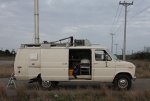|
I think the BBHN network is working just fine. Your Pi just isn't configured properly.
Are there any devices that autoconfigure "properly" when connected to two upstream DHCP sources like that?
I don't think the necessary routing information is available in the DHCP protocol.
Depending on what is connected in the mesh, you may be able to route just 10.x.x.x through the mesh, or you may be able the entire internet through the mesh. The mesh can't tell whether it has to best connection to, for instance google.com, or whether the "other" link on your Pi has a better connection. The mesh node has no way to figure out what network is available on the other link into your Pi. All the mesh can tell your Pi is Client IP, Router IP, LAN subnetmask, DNS server IP, and domain name. The routing happens in your Pi, so it would be up to the Pi to look at the DHCP information and decide what routing to use. DHCP is going to tell the Pi to use router IP of, for instance, 10.217.95.249, and a netmask of 255.255.255.248. How is the Pi supposed to automatically figure out that you really want routing to 10.x.x.x with a netmask of 255.255.255.0? Then if your wifi connection goes away, it will be up to your Pi to figure that out. I guess you could configure your Pi as an OLSR mesh node and configure it to connect to BBHN. I think you can connect two BBHN nodes through their LAN ports, not just through RF.
I guess you could write some scripts to run on your Pi, but I don't think there's any kind of general purpose dual uplink routing options. Your script would be specifically for BBHN and a separate internet connection. I guess you could look into the routing table for an address like 10.215.95.249 and then formulate an appropriate route add 10.0.0.0 ... entry when needed.
|
